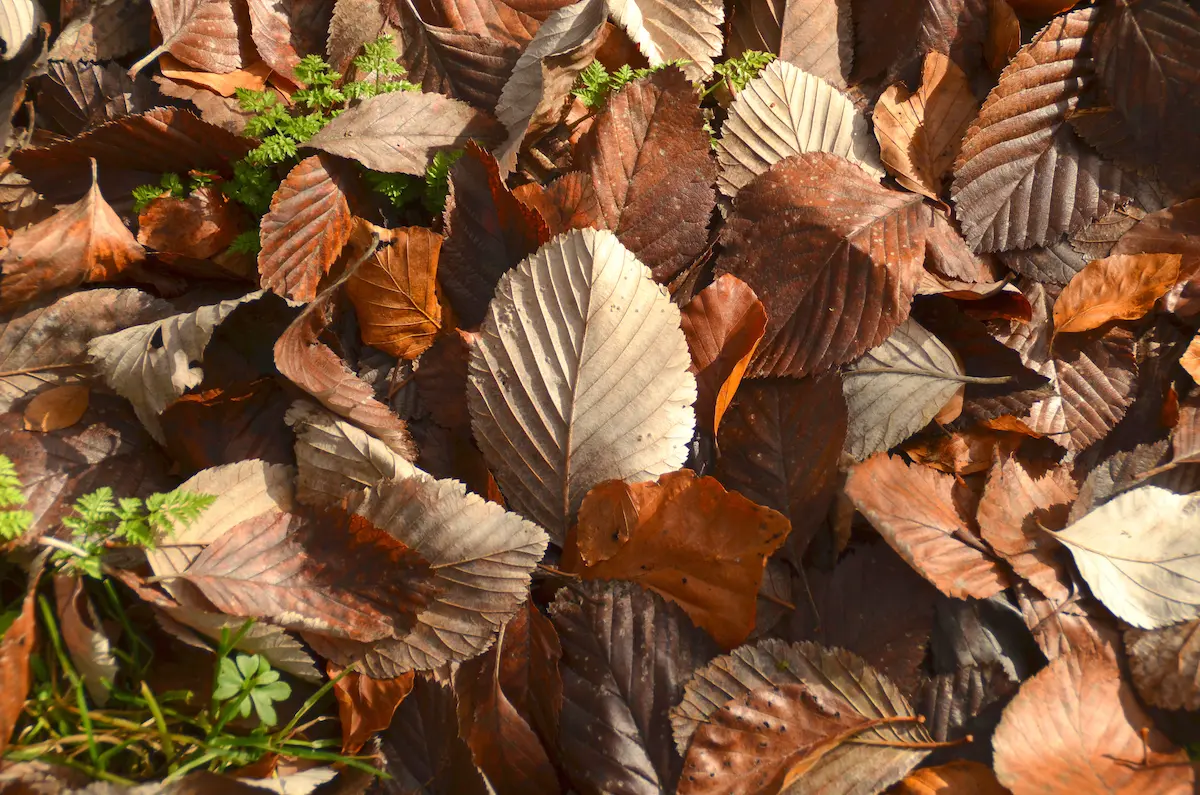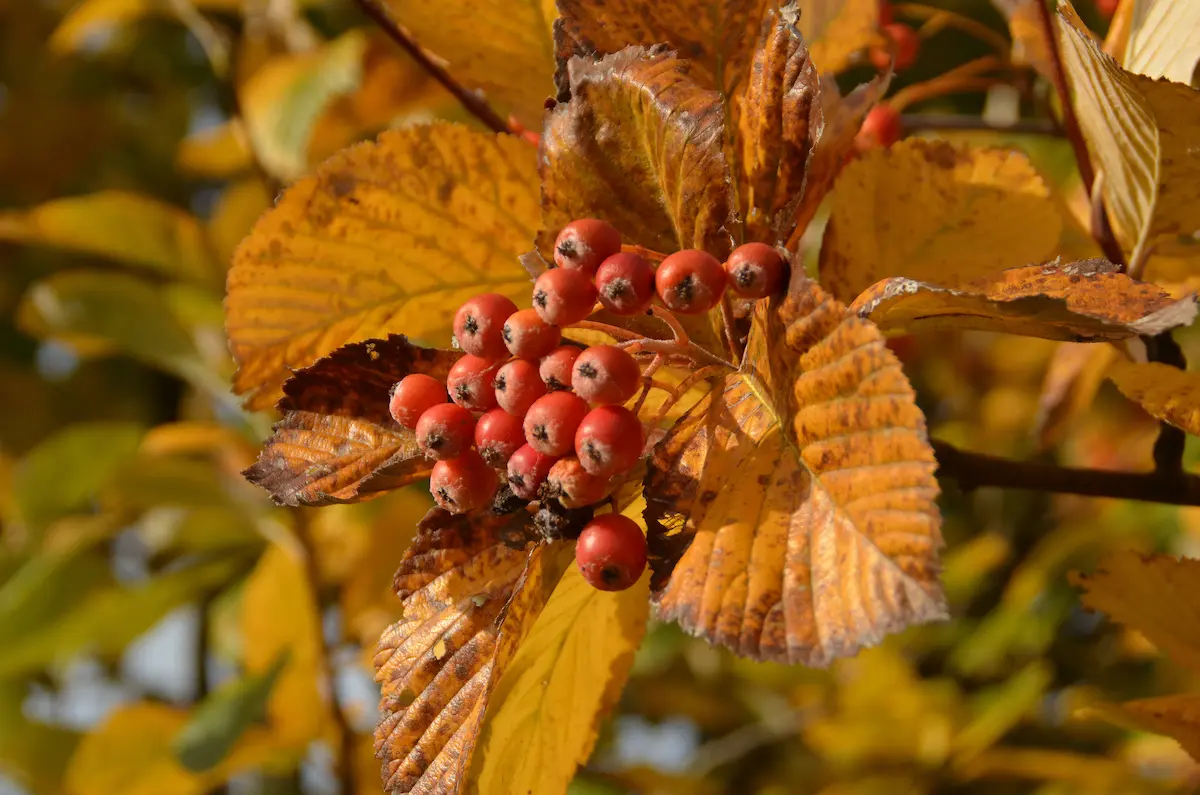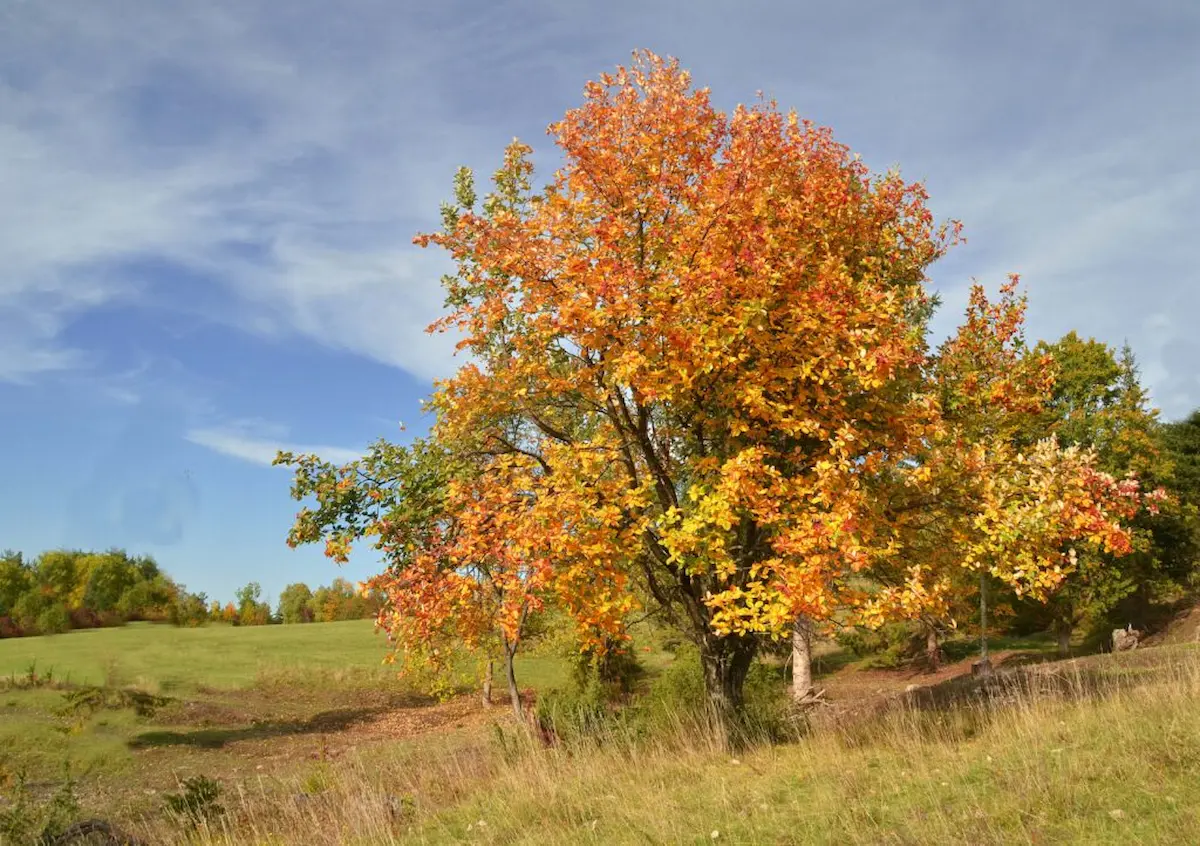At the end of 2023, this year's Tree of the Year was chosen by the "Tree of the Year - Dr Silvius Wodarz Foundation" and its advisory board, the "Tree of the Year Board of Trustees" (KBJ). The choice fell on the common service tree (Sorbus aria).
Despite its relatively low growth height of 12-15 metres, it is an impressive tree species that can reach an age of 150-200 years. It shows its full beauty especially in autumn, when the orange to scarlet fruits shine through the yellow to golden-brown crown of leaves. But it also impresses in spring with its white flowers, which exude a fragrant scent and attract numerous insects. This is also when its large, sticky, brown and green iridescent buds open, revealing shoots, leaves and flower buds covered in dense silver-grey hairs. This pubescence then gradually disappears, but remains on the flowers and later fruit stems, and above all on the undersides of the leaves as protection against evaporation until autumn.
Tree of open landscapes
The light-loving rowan migrated across south-eastern Europe after the last ice age and is now at home around the western Mediterranean and in parts of western and central Europe. Its natural northern distribution limit runs via southern England and Belgium across Germany via the Eifel, northern Hesse and the Thuringian Forest. In Germany, it is mainly a tree of hilly and mountainous landscapes up to the Alpine region, where it climbs up to around 1600 metres.

Above all, sunny locations and little competition are important to it. This is why the rowan is usually found on forest edges, in heathland areas and on rough and dry grasslands. It also thrives on steep slopes and boulder slopes, but usually develops there in multi-stemmed or shrub form. It loves - even if it is not dependent on - calcareous soils.
Its preference for light and sunny locations makes it a pioneer tree that has already gained a foothold in the forest areas that are currently collapsing as a result of global warming. However, due to its comparatively slow growth, the rowan will presumably be displaced from these areas quite soon by other regrowing tree species.
New career in the city
In future, the rowan will increasingly be seen in urban areas. The reason why it is now a popular city and park tree has to do with the expectation that it will also cope well with increasingly dry periods. "The species will play an important role in the greening of cities in the future," explains Stefan Meier, President of the Tree of the Year Foundation. The German National Conference of Garden Managers (GALK) has included the rowan in the list of future trees for the city because it helps to improve the urban microclimate and provides cooling. Outside the cities, it is also often planted as an avenue tree - primarily on secondary roads.
The berries are more appealing to birds than to humans
The fruits of the serviceberry are roundish-oval and one to one and a half centimetres in size. They are usually called berries. Botanically correct, however, would be to call them apple fruits, because as with the apple, which is a close relative of the rowan, the actual fruit is only the so-called core. This tastes mealy and rather dull. After the first frost, however, the tannin content is reduced and a certain sweetness comes through, so that the juice of the fruit can at least be added to juices, jams and jellies. Vinegar or brandy can also be produced by adding sugar. However, the fruits of the rowan tree have never achieved any major economic significance.
Birds, on the other hand, like them, especially thrushes, but also bullfinches and waxwings. They are also the main contributors to the spread of this tree. Many mammals, from mice to wild boar, also enjoy the berries, but usually have to wait until the following year to see if the birds have left anything. This is because the fruit clusters are so-called winter harvesters, which only gradually fall off the following year. Due to its benefits for wildlife, the tree species has been increasingly planted in recent years to promote nature and species conservation.

It is not clear why this year's tree of the year is called the rowan. In addition to the floury flavour of the fruit, the floury-looking young shoots and undersides of the leaves or the admixture of dried rowan fruits to make flour in times of need are also thought to have contributed to the name.
The tree of the year likes to cross
The rowan and some related species tend to bastardise. This means that they not only cross and reproduce within their own species, but occasionally also with closely related species. The rowan is considered to be extremely bastardising. There are numerous hybrids with closely related species such as rowan, wild service tree or dwarf rowan. But it also hybridises with less closely related species such as the chokeberry (Aronia) or the cultivated pear.
These rowan bastards are generally sterile. Because the structures of the parental chromosomes are too different, development into an egg cell capable of fertilisation is blocked. However, the rowan bastards have found an obvious way to produce their own offspring: a normal cell in the tissue near the blocked egg cell can be re-tuned and stimulated to form germinable seeds. Pollination of the flower, but without subsequent fertilisation, can promote this re-tuning.
From the outside and with the naked eye, nothing unusual can be recognised: The rowan bastard flowers, the flower is pollinated and germinable seeds are formed in the developing fruit. However, as no fertilisation has taken place, these offspring are naturally cloned plants, completely identical to their mother plant. And these and all other offspring can then continue to reproduce in the same asexual way. These so-called "constant hybrids" are now regarded as independent species.
Text: Peter Grett based on a description by Dr Rudolf Fenner
Pictures: Dr Silvius Wodarz Foundation

